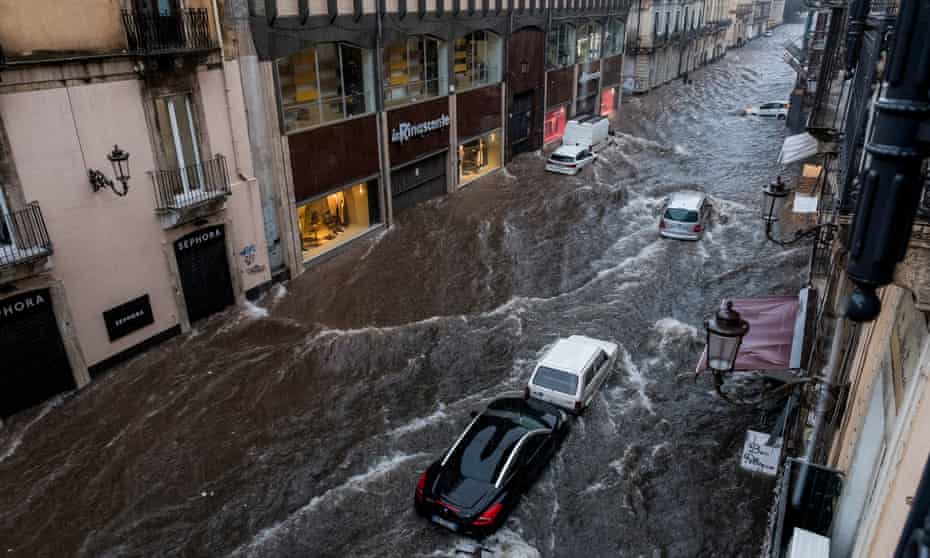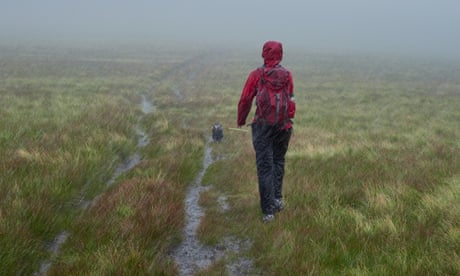‘Medicane’ storm with winds of 100km/h expected in Sicily, where two have died in flooding

A street becomes a river in the Sicilian city of Catania.
Photograph: Sanne Derks/Getty Images
Lorenzo Tondo in Palermo
@lorenzo_tondo
Wed 27 Oct 2021
Southern Italy was braced on Wednesday for the arrival of what forecasters have described as a Medicane – a rare Mediterranean hurricane bringing winds of more than 100kmh and producing 5-metre waves.
Fierce storms have battered Sicily for days, leaving roads submerged in the eastern part of the island and claiming the lives of at least two people. Video footage shows flood waters engulfing the city of Palermo, turning streets into rivers and squares into lakes.
Italy’s department for civil protection issued its most severe weather warning for Sicily and Calabria on Tuesday, as Italian authorities confirmed the death of a 53-year-old man who drowned in Gravina, a town north of Catania. The death comes after the body of a 67-year-old man was found on Monday in Scordia. Rescuers are still searching for his 54-year-old wife.
![]()
01:22 Heavy rain causes flash floods in Sicily – video
On Tuesday, Catania’s mayor, Salvo Pogliese, called the weather events “unprecedented” and ordered the closure of all businesses.
“I urge the entire population to not leave home except for emergency reasons, because roads are overrun by water,” he said on Facebook.
Forecasters have said the Medicane is the latest evidence demonstrating how the climate emergency is irremediably tropicalising the Mediterranean.

Met office warns of life-threatening flooding in parts of UK
“Sicily is tropicalising and the upcoming Medicane is perhaps the first of this entity, but it certainly won’t be the last,” said Christian Mulder, a professor of ecology and climate emergency at the University of Catania. “We are used to thinking that this type of hurricane and cyclone begins in the oceans and not in a closed basin like the Mediterranean. But this is not the case.
“This Medicane is forming due to the torrid climate of north Africa and the warm waters of the Mediterranean Sea. The Aegean Sea has a temperature of 3C higher than the average, while the Ionian Sea has a temperature of almost 2C higher than the average. The result is a pressure cooker.”
According to forecasters, the Medicane could reach Sicily on Thursday or Friday and could finally leave the area between Saturday and Sunday.
“We are facing something exceptional,” said Giulio Betti, a meteorologist and climatologist at Italy’s national research council.
“What is affecting Sicily and Calabria is a hybrid atmospheric event. It has the typical characteristics of a subtropical cyclone, but at times it holds the characteristics of a tropical-like cyclone.
“The unique aspect is its duration and its stationing – that is, this atmospheric event is hard to dissolve. … on the one hand it continues to be fed by the cool western currents; on the other hand it is unable to move eastward, due to the Balkans’ anticyclone.”
The signs of change are becoming more frequent in Sicily, where in August a monitoring station in the south-eastern city of Syracuse recorded a temperature of 48.8C, the highest ever set in Europe. Data collected by the Balkans and Caucasus observatory put the average temperature rise on the island over the past 50 years at almost 2C, rising to 3.4C in Messina on the north-east coast.
In September two people were killed and nine injured after a tornado tore through the Italian island of Pantelleria. The whirlwind ripped off roofs and flipped over at least six cars, with residents describing the scene as “apocalyptic”.
Scientists say the climate emergency could sweep traditional agricultural crops from the Mediterranean, leaving growers to search for tropical alternatives. In the past three years the production of avocados, mangos and papaya has doubled in Sicily, while in Palermo’s botanical garden researchers have registered for the first time the blooming of welwitschia, a native of the southern African Namib desert.
Early in October, the coffee company Morettino produced for the first time its own coffee in Sicily, in a development that could turn the Italian island into the northernmost coffee plantation in the world.
Lorenzo Tondo in Palermo
@lorenzo_tondo
Wed 27 Oct 2021
Southern Italy was braced on Wednesday for the arrival of what forecasters have described as a Medicane – a rare Mediterranean hurricane bringing winds of more than 100kmh and producing 5-metre waves.
Fierce storms have battered Sicily for days, leaving roads submerged in the eastern part of the island and claiming the lives of at least two people. Video footage shows flood waters engulfing the city of Palermo, turning streets into rivers and squares into lakes.
Italy’s department for civil protection issued its most severe weather warning for Sicily and Calabria on Tuesday, as Italian authorities confirmed the death of a 53-year-old man who drowned in Gravina, a town north of Catania. The death comes after the body of a 67-year-old man was found on Monday in Scordia. Rescuers are still searching for his 54-year-old wife.
01:22 Heavy rain causes flash floods in Sicily – video
On Tuesday, Catania’s mayor, Salvo Pogliese, called the weather events “unprecedented” and ordered the closure of all businesses.
“I urge the entire population to not leave home except for emergency reasons, because roads are overrun by water,” he said on Facebook.
Forecasters have said the Medicane is the latest evidence demonstrating how the climate emergency is irremediably tropicalising the Mediterranean.

Met office warns of life-threatening flooding in parts of UK
“Sicily is tropicalising and the upcoming Medicane is perhaps the first of this entity, but it certainly won’t be the last,” said Christian Mulder, a professor of ecology and climate emergency at the University of Catania. “We are used to thinking that this type of hurricane and cyclone begins in the oceans and not in a closed basin like the Mediterranean. But this is not the case.
“This Medicane is forming due to the torrid climate of north Africa and the warm waters of the Mediterranean Sea. The Aegean Sea has a temperature of 3C higher than the average, while the Ionian Sea has a temperature of almost 2C higher than the average. The result is a pressure cooker.”
According to forecasters, the Medicane could reach Sicily on Thursday or Friday and could finally leave the area between Saturday and Sunday.
“We are facing something exceptional,” said Giulio Betti, a meteorologist and climatologist at Italy’s national research council.
“What is affecting Sicily and Calabria is a hybrid atmospheric event. It has the typical characteristics of a subtropical cyclone, but at times it holds the characteristics of a tropical-like cyclone.
“The unique aspect is its duration and its stationing – that is, this atmospheric event is hard to dissolve. … on the one hand it continues to be fed by the cool western currents; on the other hand it is unable to move eastward, due to the Balkans’ anticyclone.”
The signs of change are becoming more frequent in Sicily, where in August a monitoring station in the south-eastern city of Syracuse recorded a temperature of 48.8C, the highest ever set in Europe. Data collected by the Balkans and Caucasus observatory put the average temperature rise on the island over the past 50 years at almost 2C, rising to 3.4C in Messina on the north-east coast.
In September two people were killed and nine injured after a tornado tore through the Italian island of Pantelleria. The whirlwind ripped off roofs and flipped over at least six cars, with residents describing the scene as “apocalyptic”.
Scientists say the climate emergency could sweep traditional agricultural crops from the Mediterranean, leaving growers to search for tropical alternatives. In the past three years the production of avocados, mangos and papaya has doubled in Sicily, while in Palermo’s botanical garden researchers have registered for the first time the blooming of welwitschia, a native of the southern African Namib desert.
Early in October, the coffee company Morettino produced for the first time its own coffee in Sicily, in a development that could turn the Italian island into the northernmost coffee plantation in the world.
No comments:
Post a Comment